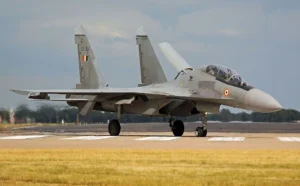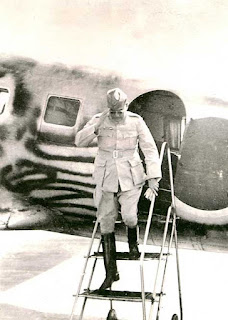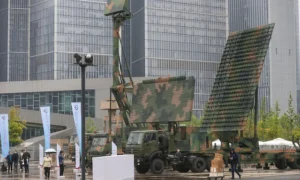Source : Indus Scrolls
 |
| Netaji Subhash Chandra Bose stands in front of the Cellular Jail at Andaman and Nicobar Islands, after its successful capture, on 30th December 1943 |
This was one of the best kept secrets in Indian history till date, thanks to the Nehruvian historiographers. Mahatma Gandhi brand of Non-cooperation movement and Netaji Subhas Chandra Bose brand of armed struggle – which one had made the most paramount impact on the British to leave India? Historical records clearly point to Netaji Subhash Chandra Bose.
Justice Chakraborti-Clement Attlee’s conversation
The year was 1976. Clement Attlee – who was the British Prime Minister when India attained Independence – was on a visit to Kolkata when Justice Phani Bhusan Chakraborti, the then Chief Justice of Calcutta High Court, was the acting Governor of West Bengal. When Justice Chakraborti asked Clement Attlee that even as the Quit India movement “practically died out long before 1947” and “there was nothing in Indian situation at that time” which made it necessary for the British to leave India, what was the tearing hurry in 1947 that they had decided to leave the country, the former British Prime Minister replied:
“…the INA activities of Netaji Subhas Chandra Bose, which weakened the very foundation of the British Empire in India, and the RIN (Royal Indian Navy) Mutiny which made the British realise that the Indian armed forces could no longer be trusted to prop up the British.”
When Justice Chakraborti asked Attlee about the extent to which the British decision to leave India was influenced by Mahatma Gandhi’s call for Quit India, the former British premier replied with a smile of disdain – “m-i-n-i-m-a-l.”
Justice Chakraborti mentioned this startling conversation with Attlee while forwarding a note of thanks – dated March 30, 1976 – to the publisher of Dr RC Majumdar’s book ‘A History of Bengal’.
RIN Mutiny
Remember Royal Indian Navy Mutiny? The stories of Subhas Chandra Bose and his INA’s tough fight to the British during the Battle of Imphal and Kohima were seeping into the heart and pulse of Indian soldiers in British forces. It was against that backdrop the RIN Mutiny took place in February, 1946. From the initial flashpoint in Bombay, the revolt spread to Karachi, Calcutta, Cochin and Vishakhapatnam. As many as 20,000 sailors of the Royal Indian Navy – in 78 ships and 20 shore establishments – had joined the mutiny. The brave sailors had demonstrated to the British that instead of serving their masters they would rise in the defence of their motherland. Holing the portraits of Netaji in their hands, the sailors were shouting Jai Hind and other INA slogans. They brought down the Union Jack on their ships and hoisted the Indian Tricolour. There were similar resistance in Royal Indian Air Force and British Indian Army. This set alarm bells ringing from Delhi to London.
Claude Auchinleck’s note
General Claude Auchinleck — then Commander-in-Chief of British Indian forces — in a confidential note, dated September 5, 1946, to British government wrote:
“The importance of keeping the Indian Army steady is emphasised. It is the one disciplined force in which communal interests are subordinated to duty, and on it depends the stability of the country. The steadiness of the RIN and the RIAF is of lesser import but any general disaffection in them is likely seriously to affect the reliability of the Army.”
IB secret report
This was what Sir Norman Smith, Director of Intelligence Bureau in British India, had noted in a secret report in 1945. The report was declassified in the 1970s.
“The situation in respect of the Indian National Army is one which warrants disquiet. There has seldom been a matter which has attracted so much Indian public interest and, it is safe to say, sympathy… the threat to the security of the Indian Army is one which it would be unwise to ignore.”
Ambedkar’s 1956 BBC interview
In a 1956 interview to BBC’s Francis Watson, Dr BR Ambedkar said:
“There are two things which led the Labour Party (government) to take this decision (to free India.) One is the Indian National Army that was raised by Subhas Chandra Bose. The British had been ruling this country in the firm belief that whatever may happen in this country and whatever the politicians may do, they will never be able to change the loyalty of the soldiers. That was the one prop on which they were carrying on their administration. That thing was completely dashed to pieces when they found that even the soldiers were being seduced to form a party or a battalion to blow off the British. I think the British came to the conclusion that if they were to rule India the only basis on which they could rule was the maintenance of the British Army. Going back to the year 1957 when the Indian soldiers rebelled against the East India Company, they found that it would never be possible for the British to supply India with enough European troops to keep their hold on it.
Secondly, the British soldiers wanted the disbandment of the Army immediately so that they could go to their civil jobs. Therefore, they could not think of having enough of a British Army to keep India down.”
Transfer of power
The British came to realise the fact that the revolt in Indian Army was something that they could not handle and that they were simply sitting on the brink of a volcano waiting to erupt at any moment soon. It was under these circumstances the British decided to transfer power to India.
Post-script
Mahatma Gandhi’s contribution to Indian freedom struggle cannot be discounted. But at the same time Subhash Chandra Bose’s decisive role in the freedom struggle of India cannot be curtailed. It is high time the Indian history made a necessary correction.









